Corn Flea Beetle
(Chaetocnema pulicaria Melsheimer)
There are several species of flea beetles that may be found in cornfields. This species is most often the one encountered. Corn flea beetles remove leaf tissue of corn as they feed and leave long scratch marks on the leaves. More importantly, corn flea beetles are the primary vector of Stewart?s wilt bacterial disease. Stewart?s wilt is an economically important disease of sweet corn hybrids and seed corn inbreds that are not resistant to it.
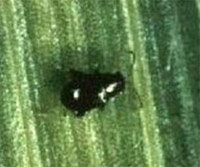
Corn Flea Beetle Adult
Description
Corn flea beetles are small, shiny,
black beetles, approximately 1/16-inch long, with enlarged hind legs.
Adults are easily disturbed and are known for their ability to jump long
distances. The larvae are small, white, and not very active. Full-grown
larvae are 1/6-inch long and most body segments are non- pigmented.
Only the prothorax and the last abdominal segment are slightly darkened.

Image courtesy of North
Carolina State University
Life Cycle
The corn flea beetle passes the
winter as an adult, in the soil and debris in fencerows, roadsides, or
the edges of woodlands. It becomes active early in the spring when
temperatures warm to 65-70°F, although they may be seenfeeding on
grasses on warm days during the winter. Corn is the primary host of the
corn flea beetle, but adults and larvae also feed on a number of
secondary hosts such asorchard grass, Kentucky bluegrass, yellow
foxtail, giant foxtail, fall panicum, and several other grasses. Wheat,
barley, oats, and Timothy have also been identified as food plants for
the flea beetle. In the spring, adults feed on corn and other hosts,
mate and lay eggs on plant leaves, in the ground, or at the base of
plants near underground stems and roots. Not much is known about the
larvae, but they feed on the roots of grass plants for about two weeks
before pupating. The generation time of the corn flea beetle is
approximately one month. However, higher temperatures result in faster
development rates. Larvae complete their development, pupate, and adults
emerge in June. The adults continue to feed on available host plants
and lay eggs for another generation. Second-generation adults appear in
early August and feed until late in the fall before overwintering.
Summer generations of thecorn flea beetle may overlap and in some
circumstances, the very southern portions of Illinois may experience a
third generation.
Injury
Little is known about damage caused by
the larvae, but damage bythe adults is very evident. The adult corn flea
beetle injures corn plants by removing leaf tissue and by transmitting
pathogenic bacteria.Injury by the adults appears as scratches in the
upper and lower surfaces of the leaf, usually parallel tothe veins. They
feed on both the upper and the lower epidermis of corn leaves, but they
do not chew completely through the leaves. The scratches, or windowpane
effect, rarely result in economic injury. High densities and heavy
feeding can result in the skeletonization of leaves and death of
seedling. The leaves of severely injured plants appear whitish or
silvery. During June and August, when the newly emerged adults appear,
the leaves of corn may be partly covered with their feeding scars.
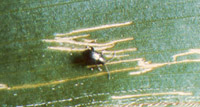
Flea beetle injury -- "windowpane effect"
More importantly, the beetles transmit the bacterium Erwinia stewartii (= Pantoea stewartii), the causal organism of Stewart?s wilt, to susceptible varieties of corn. During the feeding process, adult flea beetles disseminate the bacterium which accumulates in and clogs the vascular system of the plant, affecting water and nutrient movement. Susceptible corn plants may become infected by E. stewartii at ant time during plant growth, and two phases of Stewart?s wilt will occur on corn. Some plants are infected in the seedling stage, whereas others may not be infected until tasselingor later. Most varieties of commercial field corn are resistantto the wilt phase of this disease while many are somewhat susceptible to the leaf blight phase. However, many seedcorn inbreds and sweet corn hybrids have varying susceptibility to Stewart?s wilt.
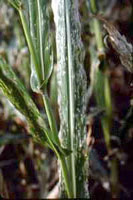
Severe Flea Beetle Feeding
Generally, field corn infested with Stewart's disease will show little sign of disease until late in the summer when numerous leaf lesions will appear on the leaves. However, in years when flea beetles are abundant and the disease is widely disseminated, some varieties of corn will wilt and the plants may die before tasseling. Drought can aggravate oraccentuate the diseased condition of a plant. The result is often small ears or no ears at all. When conditions are favorable for both the beetles and the wilt, nearly 100 percent of the susceptible varieties of field corn will show symptoms of Stewart's disease by late fall.
Evidence of Stewart's disease is more common and the results more drastic in sweet corn than in field corn. Sweet corn plants infected at an early stage are usually most severely affected. Infected young plants usually wilt, become stunted, and exhibit water-soaked lesions with wavy margins. The late infection phase or ?leaf blight phase? of Stewart?s wilt occurs after tasseling and is generally not a concern in sweet corn because ears are harvested before damage occurs.
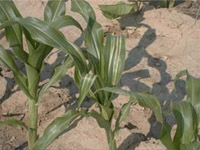
Stewart's Wilt in Sweet Corn
Scouting Procedure
Corn should be scouted for
corn flea beetles when plants begin to emerge in the spring. Examine
newly emerged corn for the presence of beetles and count the approximate
number per plant. They will first appear around field edges as they
move from grassy areas and other overwintering sites.
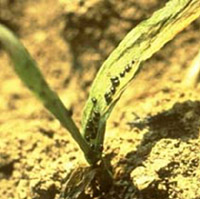
Corn Flea Beetles on Seedling Corn Plant
Field Corn. Control may be justified in commercial corn when there is an average of five or more beetles per plant prior to the 4-leaf stage. If the infestation is so severe that some plants are being killed, or if more than half the leaves are whitish, it may be profitable to treat.
Seed Corn. Prior to the 5-leaf stage, susceptible seedcorn inbreds may require an insecticidal treatment when 2 to 3 beetles per plant are present and 10% of the plants are silver or whitish due to severe foliar feeding.
Sweet Corn. In susceptible sweet corn hybrids, some recommendations suggestrescue treatments when the threshold of 6 beetles per 100 plants is reached.
Treatment decision considerations should include flea beetle densities, plant growth stages, and environmental conditions. Plants in hot and dry surroundings are more likely to suffer from leaf feeding injury than those plants growing under more ideal conditions.
Management
Corn flea beetles acquire the
bacterium that causes Stewart?s wilt from infected plants during the
summer and fall, and the bacterium overwinters in the gut of the flea
beetle. Like many insects, winter survival of the corn flea beetle is
affected by the severity of the winter. Mild winters improve the
survivability of the corn flea beetle as well as the bacterium that
causes Stewart?s wilt. The probability of Stewart?s wilt during a
growing season can be predicted using a Winter Temperature Index. Based
on the Stevens-Boewe system, the current model of the temperature index
predicts the severity of Stewart?s wilt based on the average monthly
temperatures of December, January, and February. By using the average
temperature of these threemonths, the index value fluctuates around the
temperature of freezing and is more easily understood. For example, when
the average ofthe winter temperatures is significantly greater than
freezing, the potential for severe Stewart?s wilt is high. When the
average temperatures drop farther below freezing, the risk of disease
decreases.
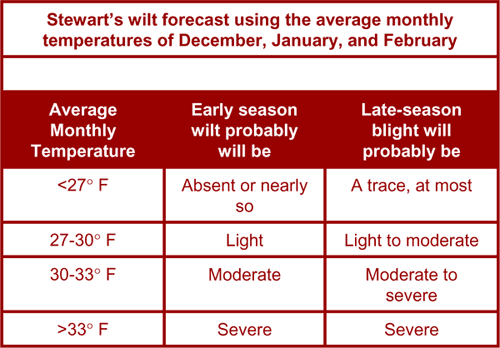
Little is known how other weather-related factors such as snow cover (depth and duration) and soil temperatures affect corn flea beetle survival over the winter and subsequent Stewart?s wilt infection the following summer.
An important management tool for Stewart?s wilt is to plant resistant hybrids. Should susceptible hybrids be used,consider altering planting dates to avoid the overwintering generation.Also begin scouting corn plants as they emerge in the spring for leaffeeding injury.
Corn flea beetle feeding may be reduced with the use of insecticidal seed treatments and foliar insecticides. Systemic seed treatments provide early season control against the corn flea beetle. The use of systemic seed treatments has been shown to reduce corn flea beetle feeding and Stewart?s wilt infection. There are a number of insecticides registered for rescue treatment of corn flea beetles during the growing season.
More Information
Corn Flea Beetle on Sweet Corn, Ohio State University Extension Fact Sheet.
Handbook of Corn Insects, Entomological Society of America.
Sweet Corn Disease Nursery: Stewart?s Bacterial Wilt, University of Illinois.